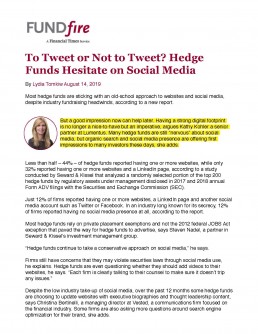Originally Published in FundFire on August 14, 2019 | By Lydia Tomkiw
Most hedge funds are sticking with an old-school approach to websites and social media, despite industry fundraising headwinds, according to a new report.
Less than half – 44% – of hedge funds reported having one or more websites, while only 32% reported having one or more websites and a LinkedIn page, according to a study conducted by Seward & Kissel that analyzed a randomly selected portion of the top 200 hedge funds by regulatory assets under management disclosed in 2017 and 2018 annual Form ADV filings with the Securities and Exchange Commission (SEC).
Just 12% of firms reported having one or more websites, a LinkedIn page and another social media account such as Twitter or Facebook. In an industry long known for its secrecy, 12% of firms reported having no social media presence at all, according to the report. Most hedge funds rely on private placement exemptions and not the 2012 federal JOBS Act exception that paved the way for hedge funds to advertise, says Steven Nadel, a partner in Seward & Kissel’s investment management group.
“Hedge funds continue to take a conservative approach on social media,” he says. Firms still have concerns that they may violate securities laws through social media use, he explains. Hedge funds are even questioning whether they should add videos to their websites, he says. “Each firm is clearly talking to their counsel to make sure it doesn’t trip any issues.”
Despite the low industry take-up of social media, over the past 12 months some hedge funds are choosing to update websites with executive biographies and thought leadership content, says Christina Bertinelli, a managing director at Vested, a communications firm focused on the financial industry. Some firms are also asking more questions around search engine optimization for their brand, she adds.
The fierce fight for talent in the hedge fund space – both between firms and with Silicon Valley – has made LinkedIn a “have to have” for firms that are looking to strengthen their digital footprint and attract new hires, Bertinelli says. “It’s employee acquisition, it’s a great tool for recruitment, and I think they are really understanding that as well,” she says.
Redemptions have continued to plague the hedge fund space this year with $44.6 billion pulled from the industry through June, as reported. Forty-six percent of hedge funds experienced a material decline in regulatory assets under management in 2018 compared to 2017, the study found. Most hedge funds haven’t been adding new private clients. Only 27% reported an increase in the number of private clients advised, while 33% showed a net
decrease, and 40% remained the same.
“The big takeaways are the long-term perspective,” Nadel says. “Even though there was a lot of [regulatory assets under management] fluctuation… The managers don’t believe that one year is an indicator of the industry.”
But a good impression now can help later. Having a strong digital footprint is no longer a nice-to-have but an imperative, argues Kathy Kohler a senior partner at
Lumentus. Many hedge funds are still “nervous” about social media, but organic search and social media presence are offering first impressions to many investors these days, she adds.
“They need to check with legal and compliance before posting and stay away from solicitation,” she says. “This is a place to build your brand.” Institutional investors are turning more to social media when researching hedge funds and their executives, and to access the content hedge funds post, including presentations at conferences that investors might not have attended. Having a strong reputation helps firms remain buoyant during tough periods, she adds. “The next couple of years? I don’t think there is a choice,” she says. “The numbers are staggering about where institutional investors are going for their information and content.”
Lumentus
Lumentus is a strategic communications consulting firm that helps its clients manage their brands, protect their reputations and improve their perceptions across target and stakeholder audiences. Lumentus Social is the firm’s social media technology and communications solutions unit, also based in the New York office. The firm’s principals are leading practitioners in the areas of corporate communications, public relations and public affairs, digital reputation management, social media, advertising and branding. Lumentus practices a discipline-agnostic approach that yields dynamic solutions able to continuously reflect changing business demands.
